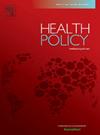The introduction of maximum reimbursement prices for digital health applications in Germany in 2022: Current developments
IF 3.6
3区 医学
Q1 HEALTH CARE SCIENCES & SERVICES
引用次数: 0
Abstract
Germany serves as a pioneering example for the integration of digital health applications. Since October 2020, digital health applications that passed a benefit evaluation have been provisionally or permanently included in the benefit basket of the German statutory health insurance. However, free price setting by the manufacturers in the first year after the introduction in the benefit basket led to high prices. After several policy debates, maximum reimbursement prices were introduced.
This article provides an overview of the changing reimbursement and pricing landscape after implementing maximum reimbursement prices. Processes of setting reimbursement prices are described, first results of maximum reimbursement prices are presented and critically reflected by views of stakeholders affected. Results of the first 1.5 years show that only four digital health applications were assigned a product-specific maximum price. For three of these digital health applications, the manufacturer's price is below the statutory health insurance's maximum reimbursement price. Although there is relatively minor impact on costs so far, this may change over the years with a growing number of digital health applications. Nevertheless, a systematic and transparent adjustment of the pricing mechanism after one year of inclusion in the benefit basket is necessary to strike a balance between the benefits of new digital health applications, statutory health insurance expenditures and the promotion of novel digital health applications.
2022年在德国引入数字医疗应用的最高报销价格:目前的发展
德国是整合数字医疗应用的先驱。自2020年10月以来,通过福利评估的数字健康申请已暂时或永久纳入德国法定健康保险的福利篮子。然而,在福利篮子引入后的第一年,制造商自由定价导致价格过高。经过几次政策辩论后,引入了最高可报销价格。本文概述了在实施最高报销价格后不断变化的报销和定价情况。描述了设定报销价格的过程,提出了最高报销价格的第一个结果,并通过受影响的利益相关者的观点进行了批判性反映。前一年半的结果显示,只有四种数字健康应用程序被指定了特定产品的最高价格。对于其中三个数字健康应用程序,制造商的价格低于法定健康保险的最高报销价格。尽管到目前为止,对成本的影响相对较小,但随着数字健康应用的不断增加,这种情况可能会发生变化。然而,在纳入福利篮子一年后,有必要对定价机制进行系统和透明的调整,以便在新的数字健康应用带来的好处、法定健康保险支出和促进新的数字健康应用之间取得平衡。
本文章由计算机程序翻译,如有差异,请以英文原文为准。
求助全文
约1分钟内获得全文
求助全文
来源期刊

Health Policy
医学-卫生保健
CiteScore
6.40
自引率
6.10%
发文量
157
审稿时长
3-8 weeks
期刊介绍:
Health Policy is intended to be a vehicle for the exploration and discussion of health policy and health system issues and is aimed in particular at enhancing communication between health policy and system researchers, legislators, decision-makers and professionals concerned with developing, implementing, and analysing health policy, health systems and health care reforms, primarily in high-income countries outside the U.S.A.
 求助内容:
求助内容: 应助结果提醒方式:
应助结果提醒方式:


